Customer Satisfaction at Inter-Ferry Service of Trinidad and Tobago
VerifiedAdded on 2022/10/06
|23
|4578
|2
Report
AI Summary
This report investigates customer satisfaction within the inter-ferry service of Trinidad and Tobago, focusing on the challenges of service cancellations and sabotage. The research explores the concept of customer satisfaction through a literature review, examining relevant theories like the CSAT and assimilation theories. The methodology employed includes a mixed-method approach, utilizing surveys and interviews to gather data. The report aims to identify the level of customer satisfaction, understand key satisfaction factors, and offer recommendations to reduce service disruptions. The findings highlight the importance of factors such as accessibility, price, quality, and responsiveness in maintaining customer satisfaction. Ultimately, the research seeks to provide insights for improving the inter-ferry service and enhancing customer experience, contributing to the economic and tourism benefits of the region.
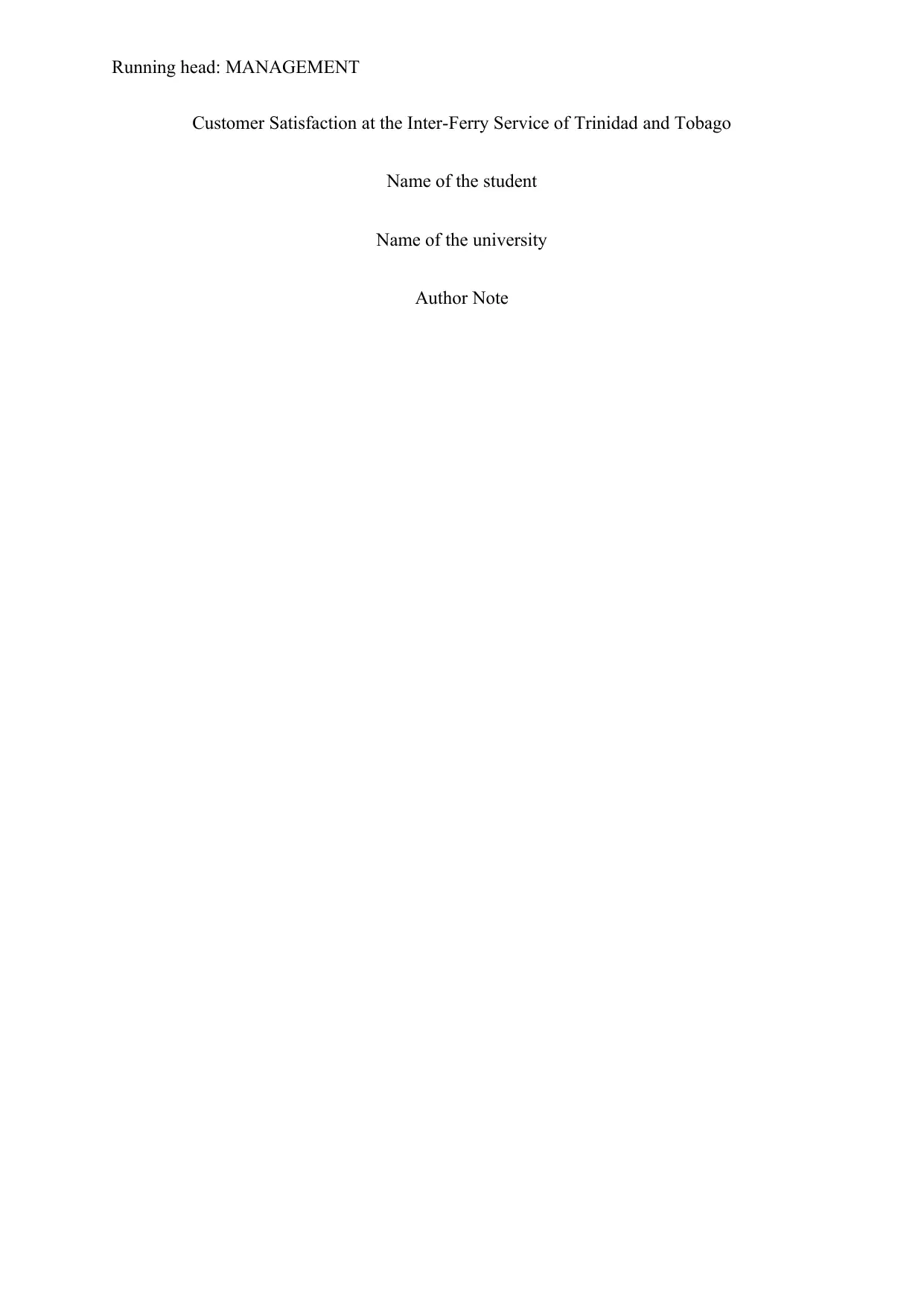
Running head: MANAGEMENT
Customer Satisfaction at the Inter-Ferry Service of Trinidad and Tobago
Name of the student
Name of the university
Author Note
Customer Satisfaction at the Inter-Ferry Service of Trinidad and Tobago
Name of the student
Name of the university
Author Note
Paraphrase This Document
Need a fresh take? Get an instant paraphrase of this document with our AI Paraphraser
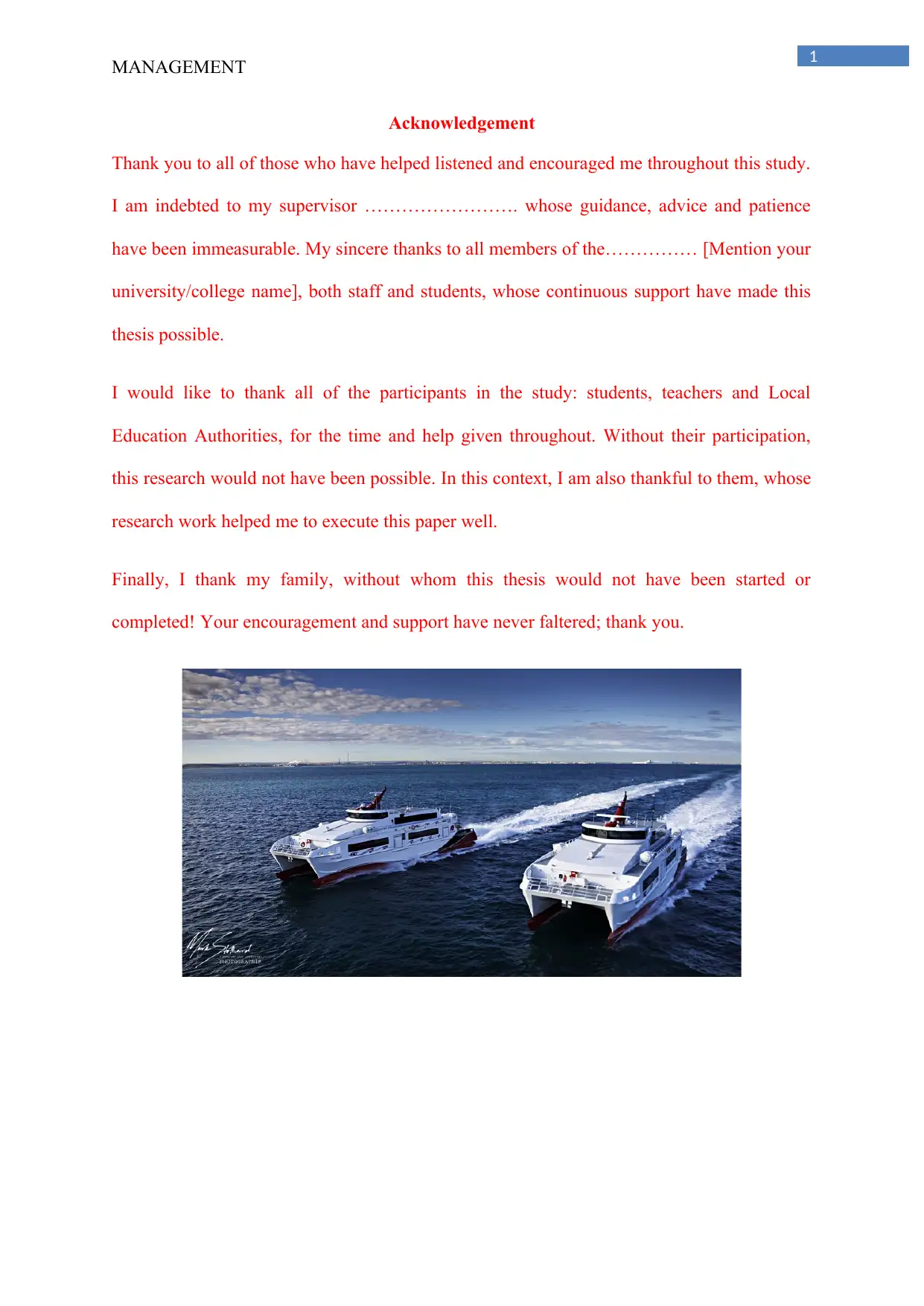
1
MANAGEMENT
Acknowledgement
Thank you to all of those who have helped listened and encouraged me throughout this study.
I am indebted to my supervisor ……………………. whose guidance, advice and patience
have been immeasurable. My sincere thanks to all members of the…………… [Mention your
university/college name], both staff and students, whose continuous support have made this
thesis possible.
I would like to thank all of the participants in the study: students, teachers and Local
Education Authorities, for the time and help given throughout. Without their participation,
this research would not have been possible. In this context, I am also thankful to them, whose
research work helped me to execute this paper well.
Finally, I thank my family, without whom this thesis would not have been started or
completed! Your encouragement and support have never faltered; thank you.
MANAGEMENT
Acknowledgement
Thank you to all of those who have helped listened and encouraged me throughout this study.
I am indebted to my supervisor ……………………. whose guidance, advice and patience
have been immeasurable. My sincere thanks to all members of the…………… [Mention your
university/college name], both staff and students, whose continuous support have made this
thesis possible.
I would like to thank all of the participants in the study: students, teachers and Local
Education Authorities, for the time and help given throughout. Without their participation,
this research would not have been possible. In this context, I am also thankful to them, whose
research work helped me to execute this paper well.
Finally, I thank my family, without whom this thesis would not have been started or
completed! Your encouragement and support have never faltered; thank you.
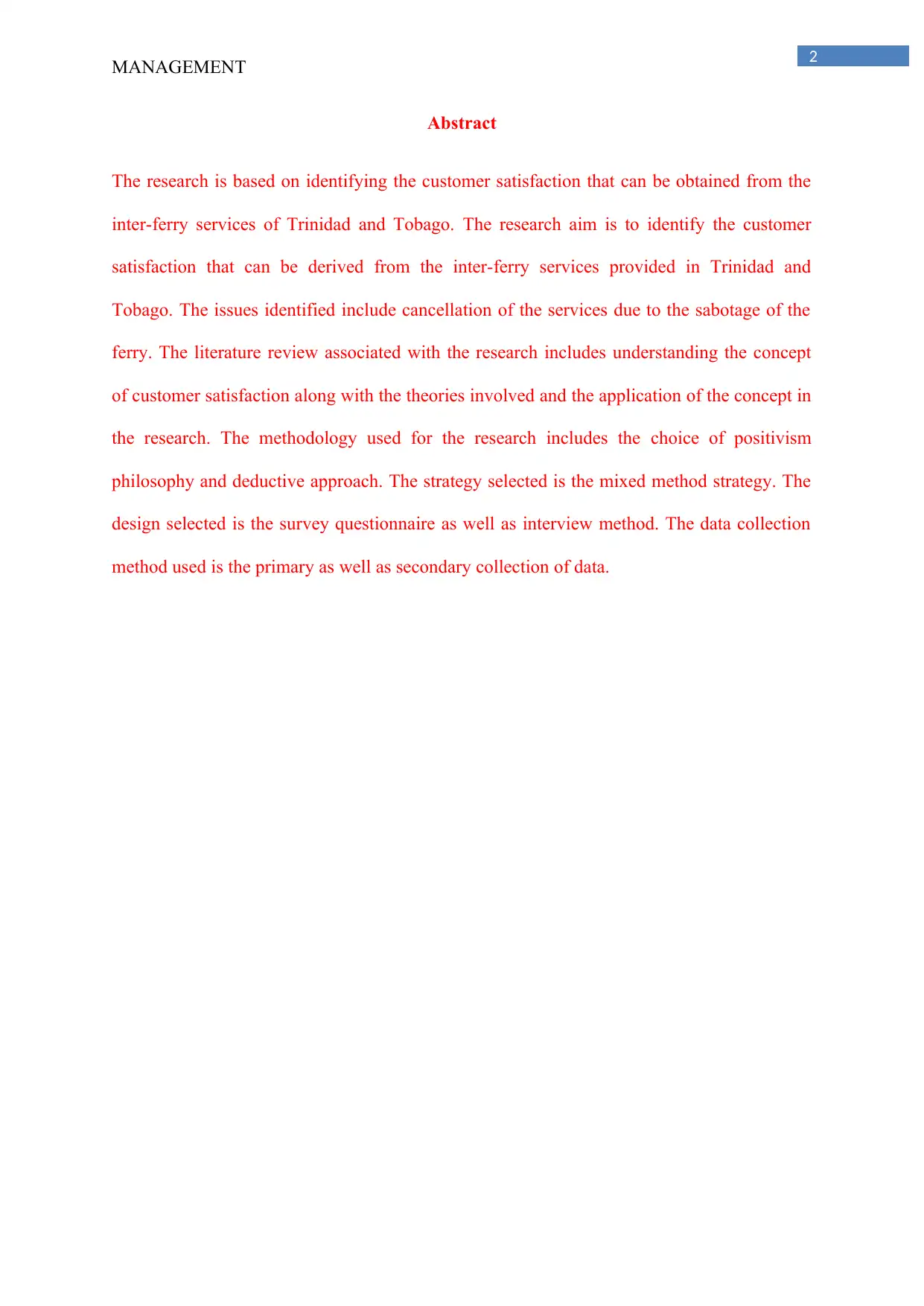
2
MANAGEMENT
Abstract
The research is based on identifying the customer satisfaction that can be obtained from the
inter-ferry services of Trinidad and Tobago. The research aim is to identify the customer
satisfaction that can be derived from the inter-ferry services provided in Trinidad and
Tobago. The issues identified include cancellation of the services due to the sabotage of the
ferry. The literature review associated with the research includes understanding the concept
of customer satisfaction along with the theories involved and the application of the concept in
the research. The methodology used for the research includes the choice of positivism
philosophy and deductive approach. The strategy selected is the mixed method strategy. The
design selected is the survey questionnaire as well as interview method. The data collection
method used is the primary as well as secondary collection of data.
MANAGEMENT
Abstract
The research is based on identifying the customer satisfaction that can be obtained from the
inter-ferry services of Trinidad and Tobago. The research aim is to identify the customer
satisfaction that can be derived from the inter-ferry services provided in Trinidad and
Tobago. The issues identified include cancellation of the services due to the sabotage of the
ferry. The literature review associated with the research includes understanding the concept
of customer satisfaction along with the theories involved and the application of the concept in
the research. The methodology used for the research includes the choice of positivism
philosophy and deductive approach. The strategy selected is the mixed method strategy. The
design selected is the survey questionnaire as well as interview method. The data collection
method used is the primary as well as secondary collection of data.
⊘ This is a preview!⊘
Do you want full access?
Subscribe today to unlock all pages.

Trusted by 1+ million students worldwide
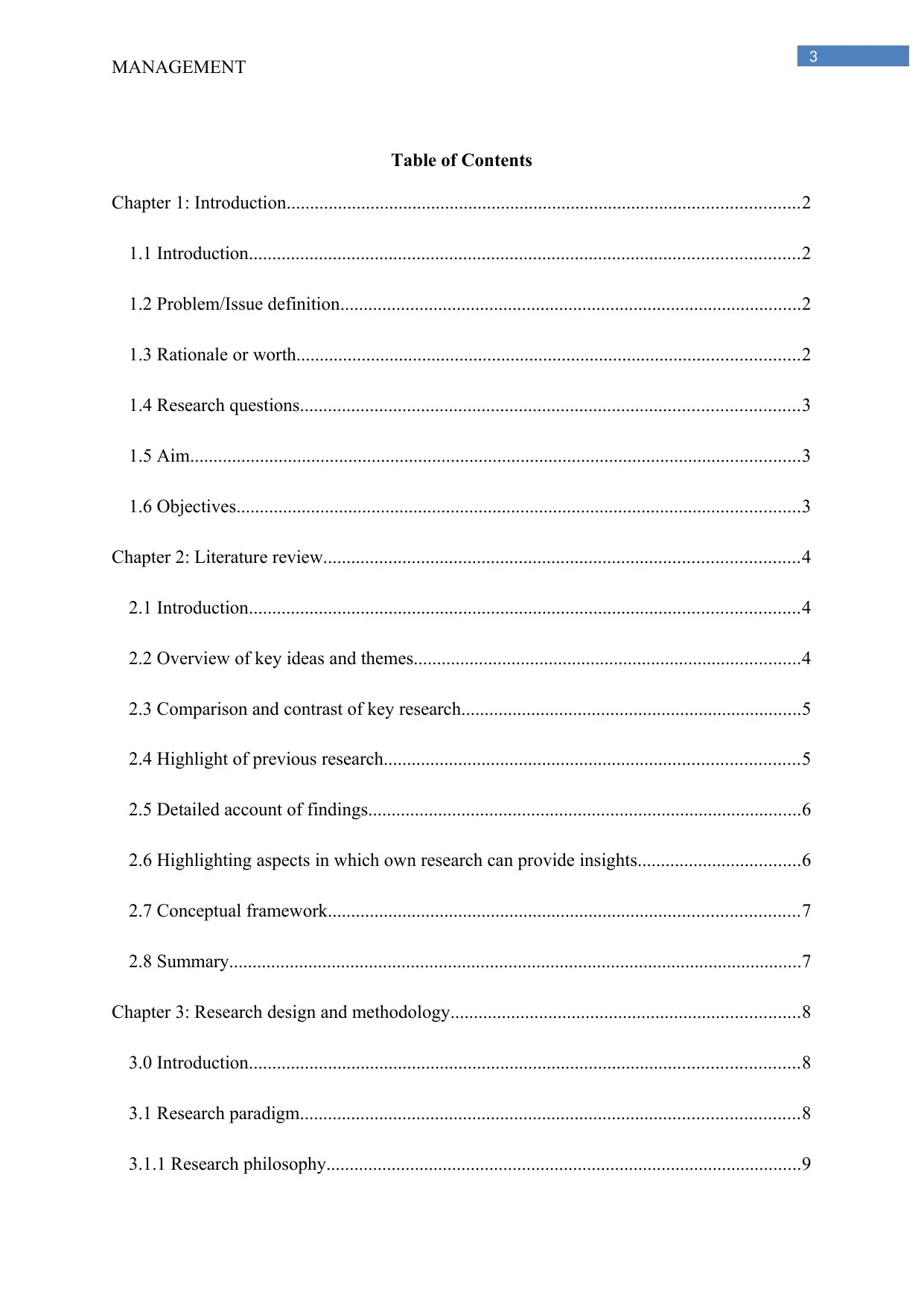
3
MANAGEMENT
Table of Contents
Chapter 1: Introduction..............................................................................................................2
1.1 Introduction......................................................................................................................2
1.2 Problem/Issue definition...................................................................................................2
1.3 Rationale or worth............................................................................................................2
1.4 Research questions...........................................................................................................3
1.5 Aim...................................................................................................................................3
1.6 Objectives.........................................................................................................................3
Chapter 2: Literature review......................................................................................................4
2.1 Introduction......................................................................................................................4
2.2 Overview of key ideas and themes...................................................................................4
2.3 Comparison and contrast of key research.........................................................................5
2.4 Highlight of previous research.........................................................................................5
2.5 Detailed account of findings.............................................................................................6
2.6 Highlighting aspects in which own research can provide insights...................................6
2.7 Conceptual framework.....................................................................................................7
2.8 Summary...........................................................................................................................7
Chapter 3: Research design and methodology...........................................................................8
3.0 Introduction......................................................................................................................8
3.1 Research paradigm...........................................................................................................8
3.1.1 Research philosophy......................................................................................................9
MANAGEMENT
Table of Contents
Chapter 1: Introduction..............................................................................................................2
1.1 Introduction......................................................................................................................2
1.2 Problem/Issue definition...................................................................................................2
1.3 Rationale or worth............................................................................................................2
1.4 Research questions...........................................................................................................3
1.5 Aim...................................................................................................................................3
1.6 Objectives.........................................................................................................................3
Chapter 2: Literature review......................................................................................................4
2.1 Introduction......................................................................................................................4
2.2 Overview of key ideas and themes...................................................................................4
2.3 Comparison and contrast of key research.........................................................................5
2.4 Highlight of previous research.........................................................................................5
2.5 Detailed account of findings.............................................................................................6
2.6 Highlighting aspects in which own research can provide insights...................................6
2.7 Conceptual framework.....................................................................................................7
2.8 Summary...........................................................................................................................7
Chapter 3: Research design and methodology...........................................................................8
3.0 Introduction......................................................................................................................8
3.1 Research paradigm...........................................................................................................8
3.1.1 Research philosophy......................................................................................................9
Paraphrase This Document
Need a fresh take? Get an instant paraphrase of this document with our AI Paraphraser
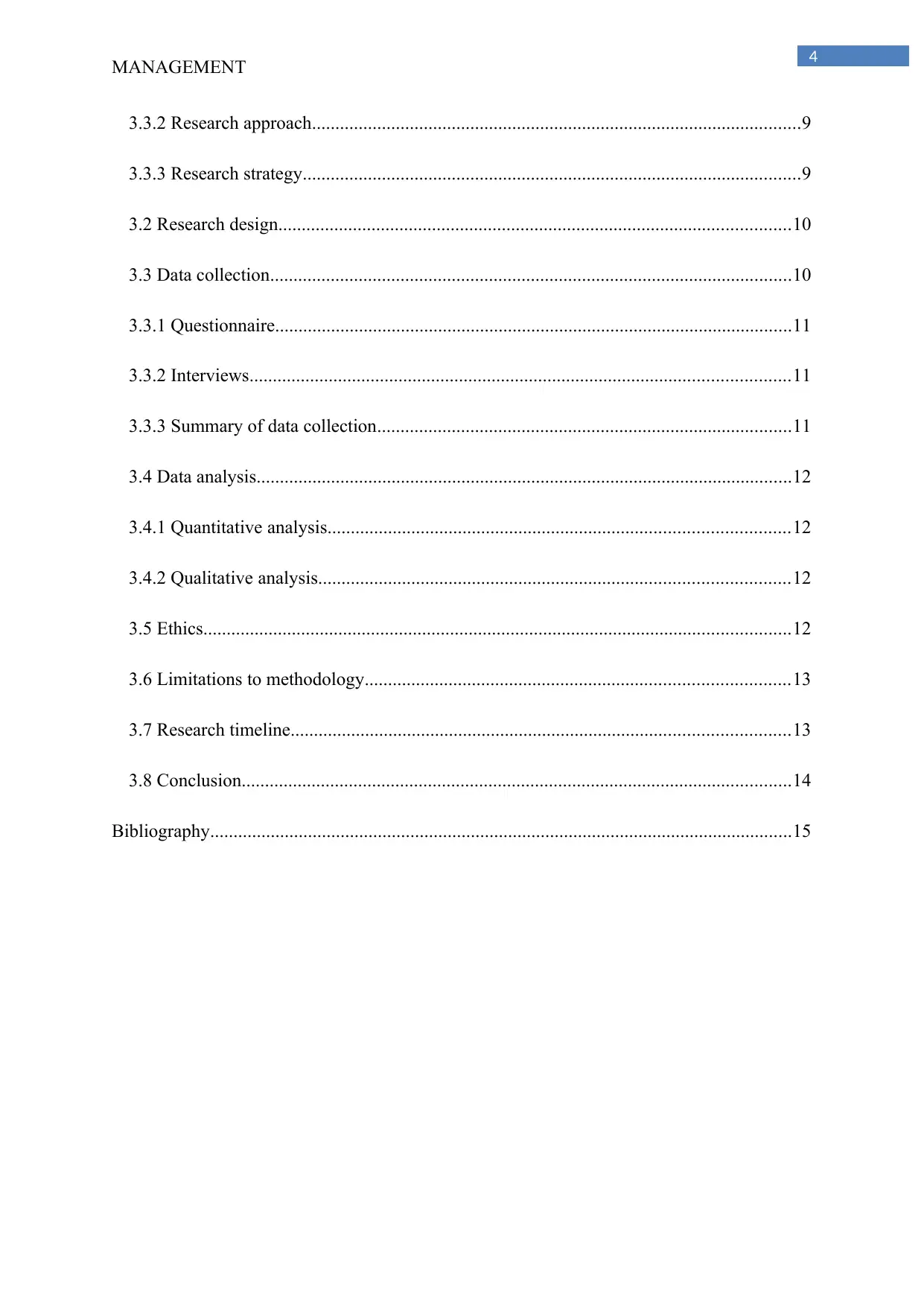
4
MANAGEMENT
3.3.2 Research approach.........................................................................................................9
3.3.3 Research strategy...........................................................................................................9
3.2 Research design..............................................................................................................10
3.3 Data collection................................................................................................................10
3.3.1 Questionnaire...............................................................................................................11
3.3.2 Interviews....................................................................................................................11
3.3.3 Summary of data collection.........................................................................................11
3.4 Data analysis...................................................................................................................12
3.4.1 Quantitative analysis...................................................................................................12
3.4.2 Qualitative analysis.....................................................................................................12
3.5 Ethics..............................................................................................................................12
3.6 Limitations to methodology...........................................................................................13
3.7 Research timeline...........................................................................................................13
3.8 Conclusion......................................................................................................................14
Bibliography.............................................................................................................................15
MANAGEMENT
3.3.2 Research approach.........................................................................................................9
3.3.3 Research strategy...........................................................................................................9
3.2 Research design..............................................................................................................10
3.3 Data collection................................................................................................................10
3.3.1 Questionnaire...............................................................................................................11
3.3.2 Interviews....................................................................................................................11
3.3.3 Summary of data collection.........................................................................................11
3.4 Data analysis...................................................................................................................12
3.4.1 Quantitative analysis...................................................................................................12
3.4.2 Qualitative analysis.....................................................................................................12
3.5 Ethics..............................................................................................................................12
3.6 Limitations to methodology...........................................................................................13
3.7 Research timeline...........................................................................................................13
3.8 Conclusion......................................................................................................................14
Bibliography.............................................................................................................................15
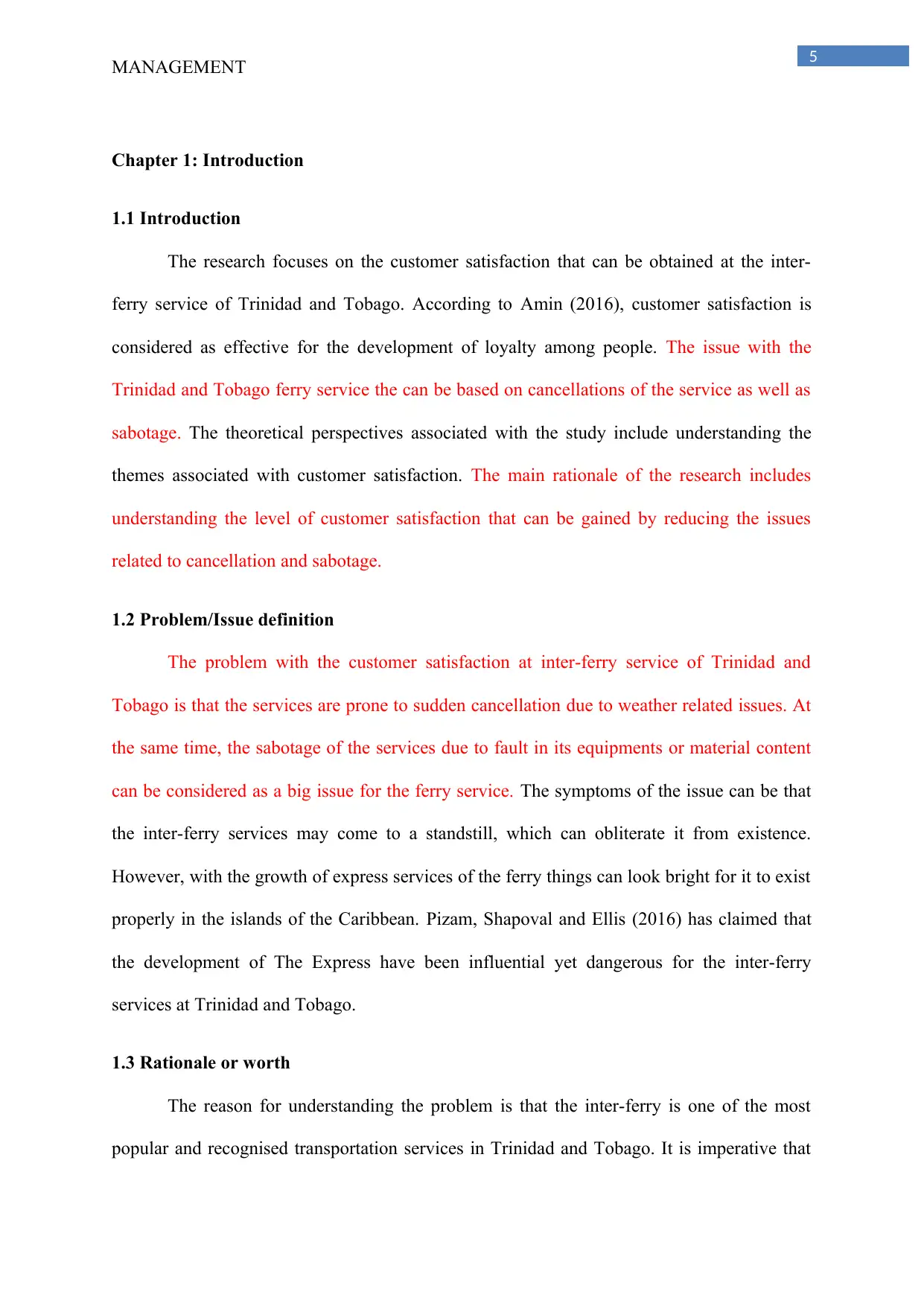
5
MANAGEMENT
Chapter 1: Introduction
1.1 Introduction
The research focuses on the customer satisfaction that can be obtained at the inter-
ferry service of Trinidad and Tobago. According to Amin (2016), customer satisfaction is
considered as effective for the development of loyalty among people. The issue with the
Trinidad and Tobago ferry service the can be based on cancellations of the service as well as
sabotage. The theoretical perspectives associated with the study include understanding the
themes associated with customer satisfaction. The main rationale of the research includes
understanding the level of customer satisfaction that can be gained by reducing the issues
related to cancellation and sabotage.
1.2 Problem/Issue definition
The problem with the customer satisfaction at inter-ferry service of Trinidad and
Tobago is that the services are prone to sudden cancellation due to weather related issues. At
the same time, the sabotage of the services due to fault in its equipments or material content
can be considered as a big issue for the ferry service. The symptoms of the issue can be that
the inter-ferry services may come to a standstill, which can obliterate it from existence.
However, with the growth of express services of the ferry things can look bright for it to exist
properly in the islands of the Caribbean. Pizam, Shapoval and Ellis (2016) has claimed that
the development of The Express have been influential yet dangerous for the inter-ferry
services at Trinidad and Tobago.
1.3 Rationale or worth
The reason for understanding the problem is that the inter-ferry is one of the most
popular and recognised transportation services in Trinidad and Tobago. It is imperative that
MANAGEMENT
Chapter 1: Introduction
1.1 Introduction
The research focuses on the customer satisfaction that can be obtained at the inter-
ferry service of Trinidad and Tobago. According to Amin (2016), customer satisfaction is
considered as effective for the development of loyalty among people. The issue with the
Trinidad and Tobago ferry service the can be based on cancellations of the service as well as
sabotage. The theoretical perspectives associated with the study include understanding the
themes associated with customer satisfaction. The main rationale of the research includes
understanding the level of customer satisfaction that can be gained by reducing the issues
related to cancellation and sabotage.
1.2 Problem/Issue definition
The problem with the customer satisfaction at inter-ferry service of Trinidad and
Tobago is that the services are prone to sudden cancellation due to weather related issues. At
the same time, the sabotage of the services due to fault in its equipments or material content
can be considered as a big issue for the ferry service. The symptoms of the issue can be that
the inter-ferry services may come to a standstill, which can obliterate it from existence.
However, with the growth of express services of the ferry things can look bright for it to exist
properly in the islands of the Caribbean. Pizam, Shapoval and Ellis (2016) has claimed that
the development of The Express have been influential yet dangerous for the inter-ferry
services at Trinidad and Tobago.
1.3 Rationale or worth
The reason for understanding the problem is that the inter-ferry is one of the most
popular and recognised transportation services in Trinidad and Tobago. It is imperative that
⊘ This is a preview!⊘
Do you want full access?
Subscribe today to unlock all pages.

Trusted by 1+ million students worldwide
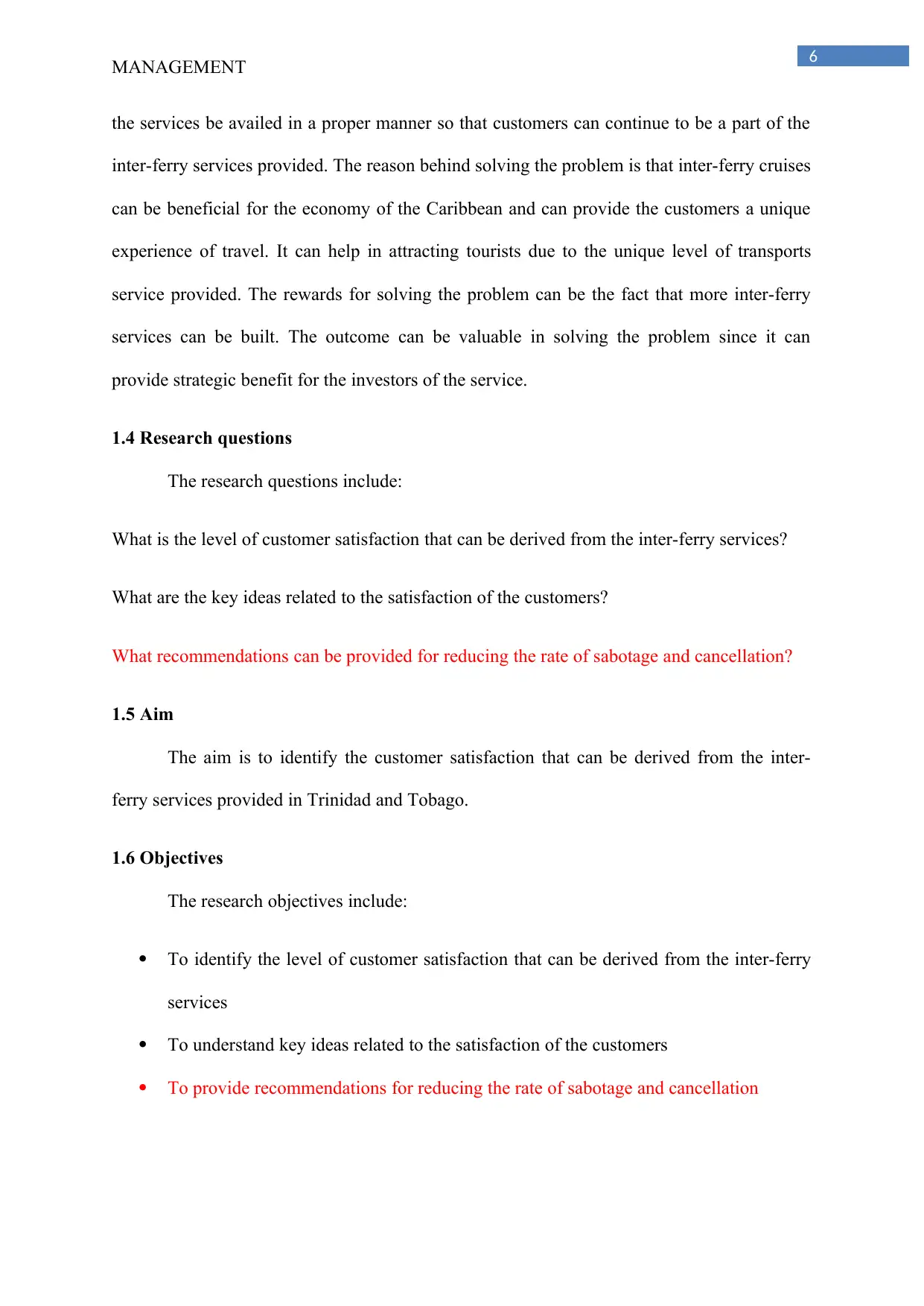
6
MANAGEMENT
the services be availed in a proper manner so that customers can continue to be a part of the
inter-ferry services provided. The reason behind solving the problem is that inter-ferry cruises
can be beneficial for the economy of the Caribbean and can provide the customers a unique
experience of travel. It can help in attracting tourists due to the unique level of transports
service provided. The rewards for solving the problem can be the fact that more inter-ferry
services can be built. The outcome can be valuable in solving the problem since it can
provide strategic benefit for the investors of the service.
1.4 Research questions
The research questions include:
What is the level of customer satisfaction that can be derived from the inter-ferry services?
What are the key ideas related to the satisfaction of the customers?
What recommendations can be provided for reducing the rate of sabotage and cancellation?
1.5 Aim
The aim is to identify the customer satisfaction that can be derived from the inter-
ferry services provided in Trinidad and Tobago.
1.6 Objectives
The research objectives include:
To identify the level of customer satisfaction that can be derived from the inter-ferry
services
To understand key ideas related to the satisfaction of the customers
To provide recommendations for reducing the rate of sabotage and cancellation
MANAGEMENT
the services be availed in a proper manner so that customers can continue to be a part of the
inter-ferry services provided. The reason behind solving the problem is that inter-ferry cruises
can be beneficial for the economy of the Caribbean and can provide the customers a unique
experience of travel. It can help in attracting tourists due to the unique level of transports
service provided. The rewards for solving the problem can be the fact that more inter-ferry
services can be built. The outcome can be valuable in solving the problem since it can
provide strategic benefit for the investors of the service.
1.4 Research questions
The research questions include:
What is the level of customer satisfaction that can be derived from the inter-ferry services?
What are the key ideas related to the satisfaction of the customers?
What recommendations can be provided for reducing the rate of sabotage and cancellation?
1.5 Aim
The aim is to identify the customer satisfaction that can be derived from the inter-
ferry services provided in Trinidad and Tobago.
1.6 Objectives
The research objectives include:
To identify the level of customer satisfaction that can be derived from the inter-ferry
services
To understand key ideas related to the satisfaction of the customers
To provide recommendations for reducing the rate of sabotage and cancellation
Paraphrase This Document
Need a fresh take? Get an instant paraphrase of this document with our AI Paraphraser
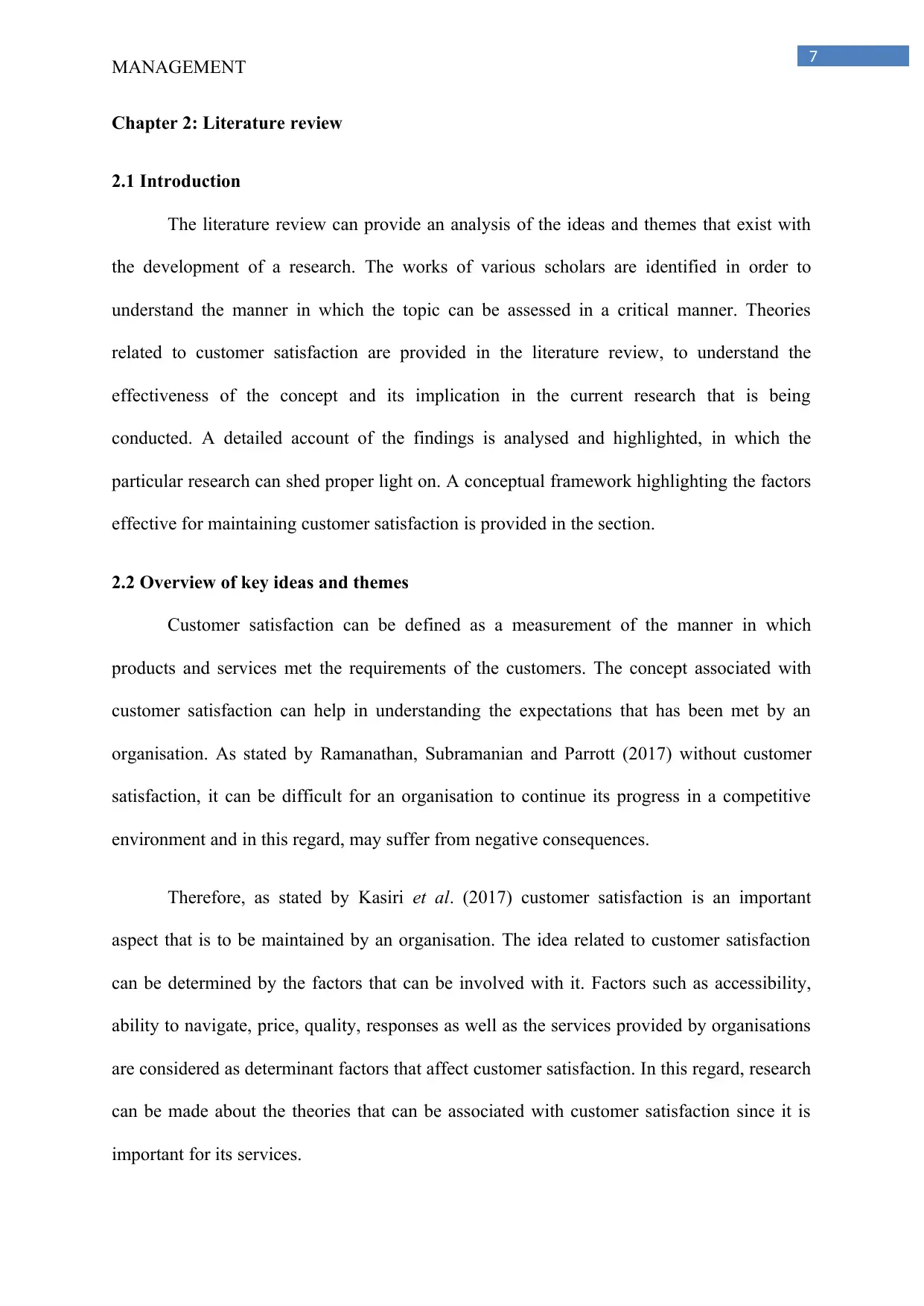
7
MANAGEMENT
Chapter 2: Literature review
2.1 Introduction
The literature review can provide an analysis of the ideas and themes that exist with
the development of a research. The works of various scholars are identified in order to
understand the manner in which the topic can be assessed in a critical manner. Theories
related to customer satisfaction are provided in the literature review, to understand the
effectiveness of the concept and its implication in the current research that is being
conducted. A detailed account of the findings is analysed and highlighted, in which the
particular research can shed proper light on. A conceptual framework highlighting the factors
effective for maintaining customer satisfaction is provided in the section.
2.2 Overview of key ideas and themes
Customer satisfaction can be defined as a measurement of the manner in which
products and services met the requirements of the customers. The concept associated with
customer satisfaction can help in understanding the expectations that has been met by an
organisation. As stated by Ramanathan, Subramanian and Parrott (2017) without customer
satisfaction, it can be difficult for an organisation to continue its progress in a competitive
environment and in this regard, may suffer from negative consequences.
Therefore, as stated by Kasiri et al. (2017) customer satisfaction is an important
aspect that is to be maintained by an organisation. The idea related to customer satisfaction
can be determined by the factors that can be involved with it. Factors such as accessibility,
ability to navigate, price, quality, responses as well as the services provided by organisations
are considered as determinant factors that affect customer satisfaction. In this regard, research
can be made about the theories that can be associated with customer satisfaction since it is
important for its services.
MANAGEMENT
Chapter 2: Literature review
2.1 Introduction
The literature review can provide an analysis of the ideas and themes that exist with
the development of a research. The works of various scholars are identified in order to
understand the manner in which the topic can be assessed in a critical manner. Theories
related to customer satisfaction are provided in the literature review, to understand the
effectiveness of the concept and its implication in the current research that is being
conducted. A detailed account of the findings is analysed and highlighted, in which the
particular research can shed proper light on. A conceptual framework highlighting the factors
effective for maintaining customer satisfaction is provided in the section.
2.2 Overview of key ideas and themes
Customer satisfaction can be defined as a measurement of the manner in which
products and services met the requirements of the customers. The concept associated with
customer satisfaction can help in understanding the expectations that has been met by an
organisation. As stated by Ramanathan, Subramanian and Parrott (2017) without customer
satisfaction, it can be difficult for an organisation to continue its progress in a competitive
environment and in this regard, may suffer from negative consequences.
Therefore, as stated by Kasiri et al. (2017) customer satisfaction is an important
aspect that is to be maintained by an organisation. The idea related to customer satisfaction
can be determined by the factors that can be involved with it. Factors such as accessibility,
ability to navigate, price, quality, responses as well as the services provided by organisations
are considered as determinant factors that affect customer satisfaction. In this regard, research
can be made about the theories that can be associated with customer satisfaction since it is
important for its services.
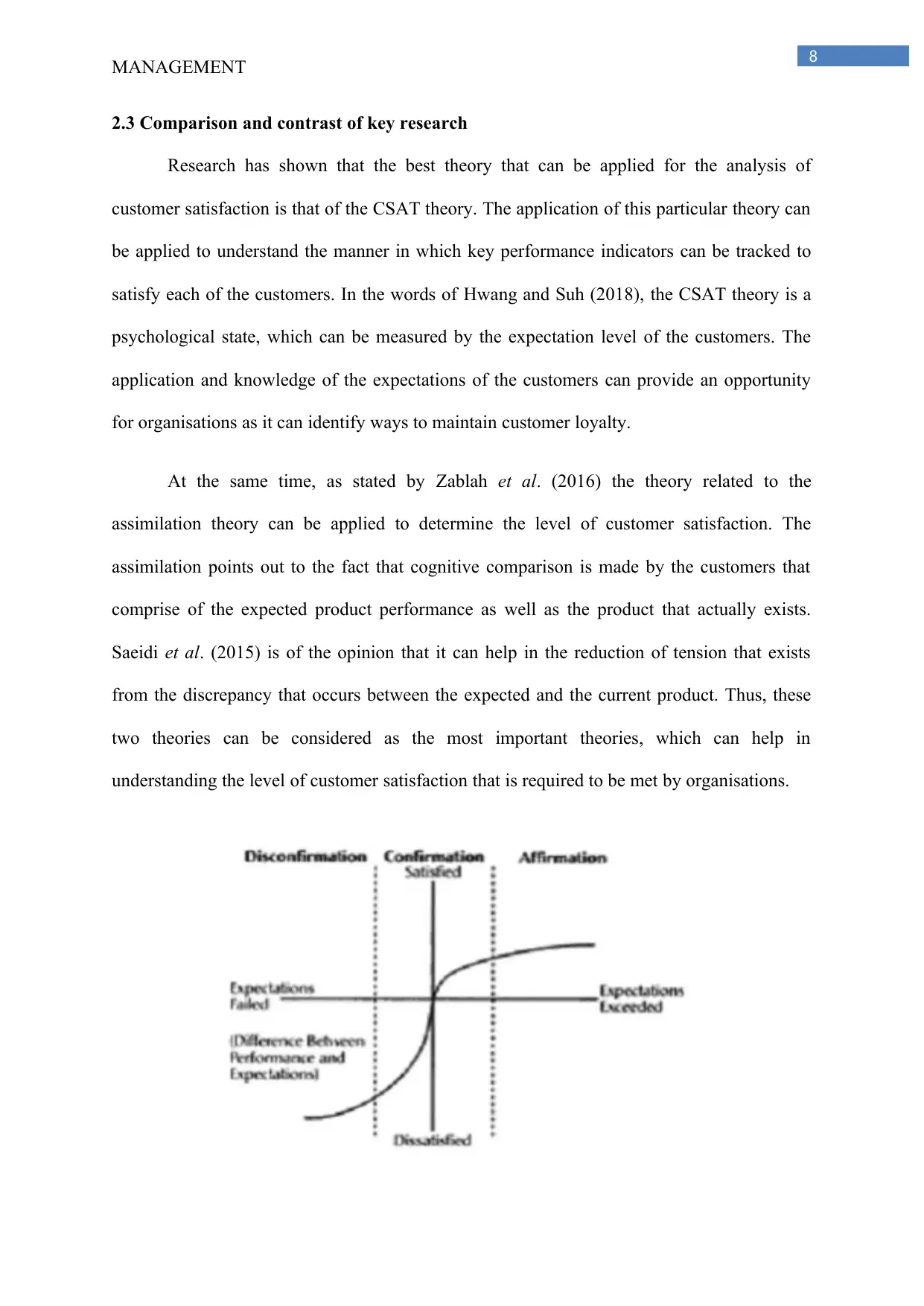
8
MANAGEMENT
2.3 Comparison and contrast of key research
Research has shown that the best theory that can be applied for the analysis of
customer satisfaction is that of the CSAT theory. The application of this particular theory can
be applied to understand the manner in which key performance indicators can be tracked to
satisfy each of the customers. In the words of Hwang and Suh (2018), the CSAT theory is a
psychological state, which can be measured by the expectation level of the customers. The
application and knowledge of the expectations of the customers can provide an opportunity
for organisations as it can identify ways to maintain customer loyalty.
At the same time, as stated by Zablah et al. (2016) the theory related to the
assimilation theory can be applied to determine the level of customer satisfaction. The
assimilation points out to the fact that cognitive comparison is made by the customers that
comprise of the expected product performance as well as the product that actually exists.
Saeidi et al. (2015) is of the opinion that it can help in the reduction of tension that exists
from the discrepancy that occurs between the expected and the current product. Thus, these
two theories can be considered as the most important theories, which can help in
understanding the level of customer satisfaction that is required to be met by organisations.
MANAGEMENT
2.3 Comparison and contrast of key research
Research has shown that the best theory that can be applied for the analysis of
customer satisfaction is that of the CSAT theory. The application of this particular theory can
be applied to understand the manner in which key performance indicators can be tracked to
satisfy each of the customers. In the words of Hwang and Suh (2018), the CSAT theory is a
psychological state, which can be measured by the expectation level of the customers. The
application and knowledge of the expectations of the customers can provide an opportunity
for organisations as it can identify ways to maintain customer loyalty.
At the same time, as stated by Zablah et al. (2016) the theory related to the
assimilation theory can be applied to determine the level of customer satisfaction. The
assimilation points out to the fact that cognitive comparison is made by the customers that
comprise of the expected product performance as well as the product that actually exists.
Saeidi et al. (2015) is of the opinion that it can help in the reduction of tension that exists
from the discrepancy that occurs between the expected and the current product. Thus, these
two theories can be considered as the most important theories, which can help in
understanding the level of customer satisfaction that is required to be met by organisations.
⊘ This is a preview!⊘
Do you want full access?
Subscribe today to unlock all pages.

Trusted by 1+ million students worldwide
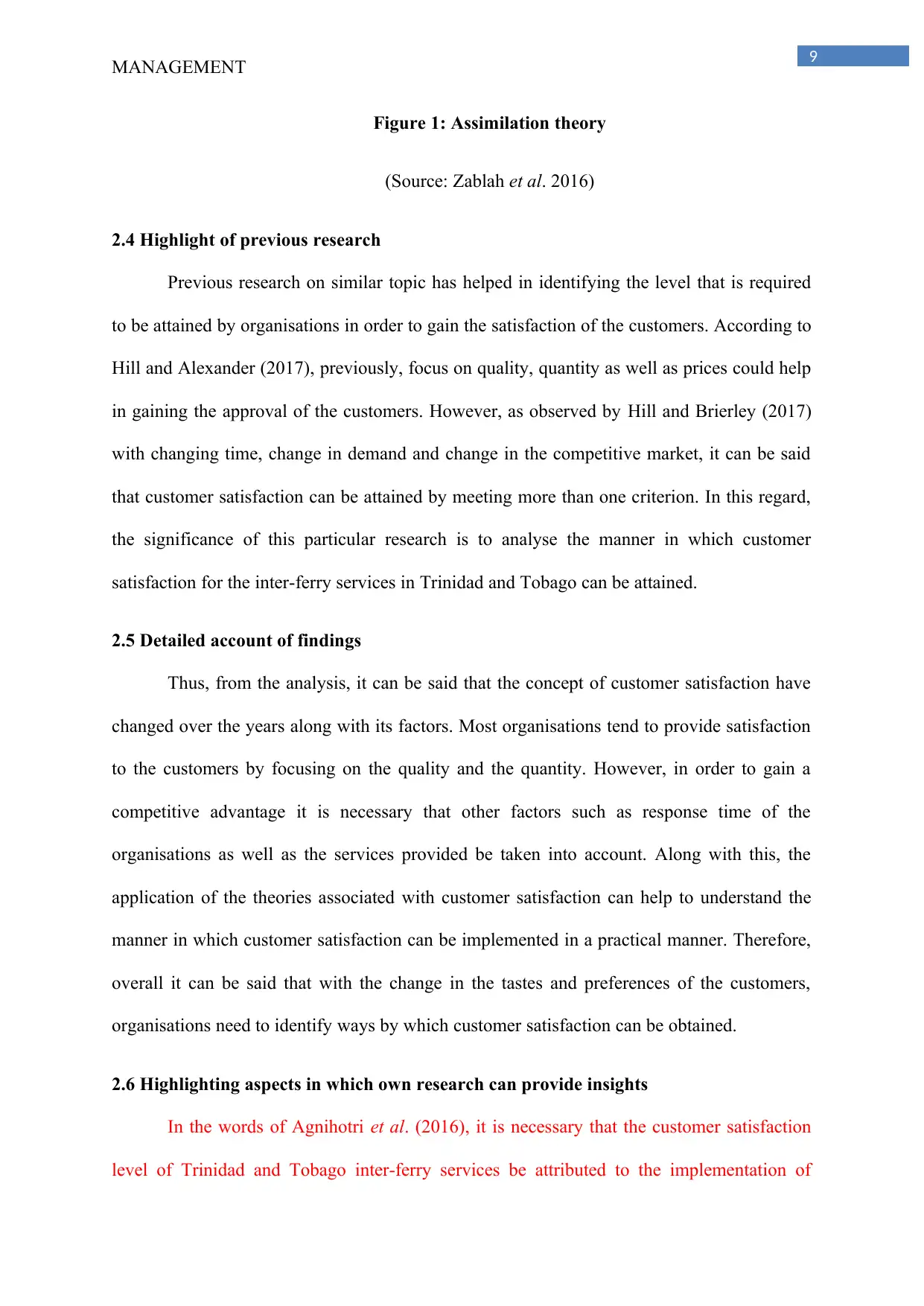
9
MANAGEMENT
Figure 1: Assimilation theory
(Source: Zablah et al. 2016)
2.4 Highlight of previous research
Previous research on similar topic has helped in identifying the level that is required
to be attained by organisations in order to gain the satisfaction of the customers. According to
Hill and Alexander (2017), previously, focus on quality, quantity as well as prices could help
in gaining the approval of the customers. However, as observed by Hill and Brierley (2017)
with changing time, change in demand and change in the competitive market, it can be said
that customer satisfaction can be attained by meeting more than one criterion. In this regard,
the significance of this particular research is to analyse the manner in which customer
satisfaction for the inter-ferry services in Trinidad and Tobago can be attained.
2.5 Detailed account of findings
Thus, from the analysis, it can be said that the concept of customer satisfaction have
changed over the years along with its factors. Most organisations tend to provide satisfaction
to the customers by focusing on the quality and the quantity. However, in order to gain a
competitive advantage it is necessary that other factors such as response time of the
organisations as well as the services provided be taken into account. Along with this, the
application of the theories associated with customer satisfaction can help to understand the
manner in which customer satisfaction can be implemented in a practical manner. Therefore,
overall it can be said that with the change in the tastes and preferences of the customers,
organisations need to identify ways by which customer satisfaction can be obtained.
2.6 Highlighting aspects in which own research can provide insights
In the words of Agnihotri et al. (2016), it is necessary that the customer satisfaction
level of Trinidad and Tobago inter-ferry services be attributed to the implementation of
MANAGEMENT
Figure 1: Assimilation theory
(Source: Zablah et al. 2016)
2.4 Highlight of previous research
Previous research on similar topic has helped in identifying the level that is required
to be attained by organisations in order to gain the satisfaction of the customers. According to
Hill and Alexander (2017), previously, focus on quality, quantity as well as prices could help
in gaining the approval of the customers. However, as observed by Hill and Brierley (2017)
with changing time, change in demand and change in the competitive market, it can be said
that customer satisfaction can be attained by meeting more than one criterion. In this regard,
the significance of this particular research is to analyse the manner in which customer
satisfaction for the inter-ferry services in Trinidad and Tobago can be attained.
2.5 Detailed account of findings
Thus, from the analysis, it can be said that the concept of customer satisfaction have
changed over the years along with its factors. Most organisations tend to provide satisfaction
to the customers by focusing on the quality and the quantity. However, in order to gain a
competitive advantage it is necessary that other factors such as response time of the
organisations as well as the services provided be taken into account. Along with this, the
application of the theories associated with customer satisfaction can help to understand the
manner in which customer satisfaction can be implemented in a practical manner. Therefore,
overall it can be said that with the change in the tastes and preferences of the customers,
organisations need to identify ways by which customer satisfaction can be obtained.
2.6 Highlighting aspects in which own research can provide insights
In the words of Agnihotri et al. (2016), it is necessary that the customer satisfaction
level of Trinidad and Tobago inter-ferry services be attributed to the implementation of
Paraphrase This Document
Need a fresh take? Get an instant paraphrase of this document with our AI Paraphraser
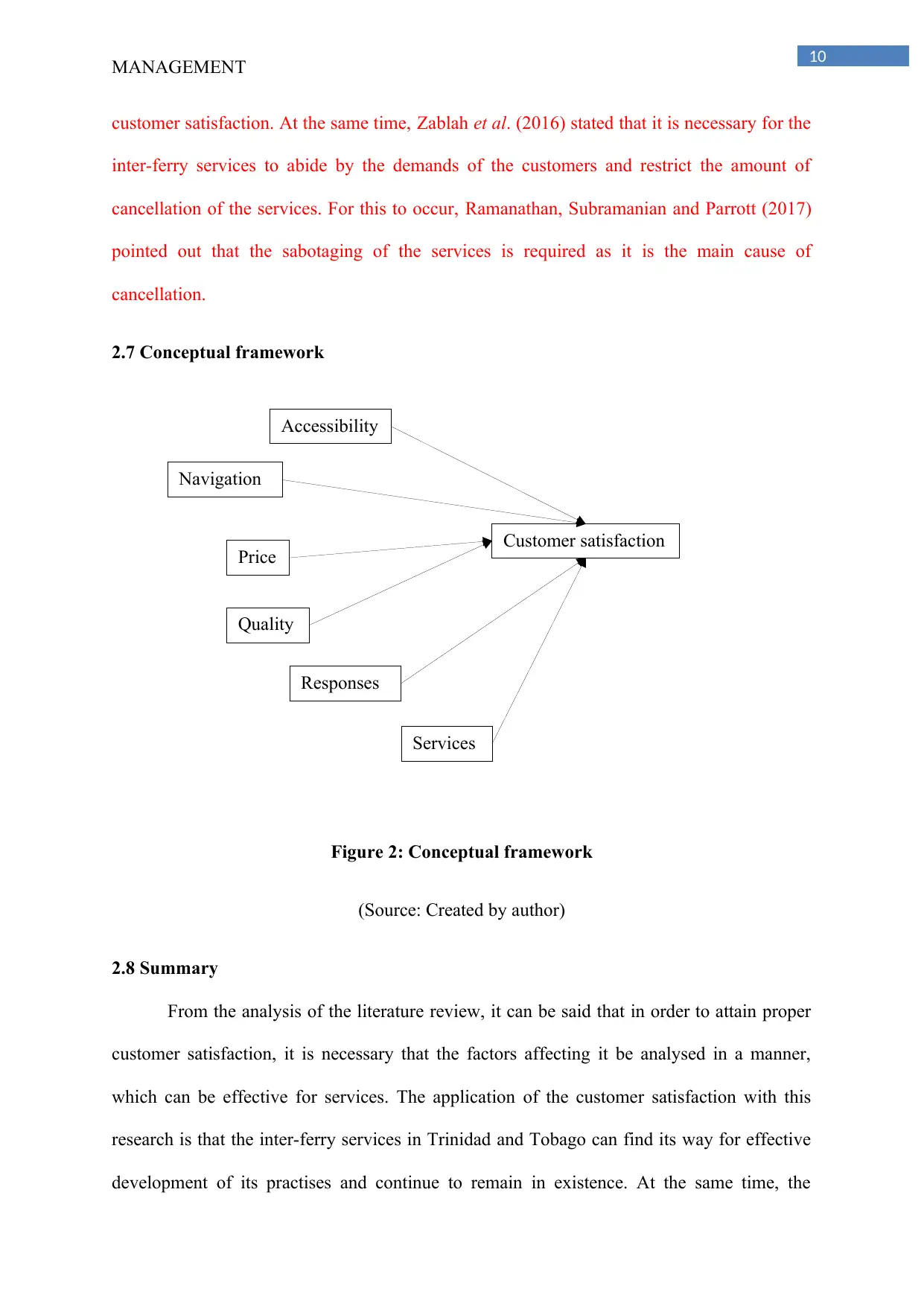
10
Accessibility
Customer satisfaction
Navigation
Price
Quality
Responses
Services
MANAGEMENT
customer satisfaction. At the same time, Zablah et al. (2016) stated that it is necessary for the
inter-ferry services to abide by the demands of the customers and restrict the amount of
cancellation of the services. For this to occur, Ramanathan, Subramanian and Parrott (2017)
pointed out that the sabotaging of the services is required as it is the main cause of
cancellation.
2.7 Conceptual framework
Figure 2: Conceptual framework
(Source: Created by author)
2.8 Summary
From the analysis of the literature review, it can be said that in order to attain proper
customer satisfaction, it is necessary that the factors affecting it be analysed in a manner,
which can be effective for services. The application of the customer satisfaction with this
research is that the inter-ferry services in Trinidad and Tobago can find its way for effective
development of its practises and continue to remain in existence. At the same time, the
Accessibility
Customer satisfaction
Navigation
Price
Quality
Responses
Services
MANAGEMENT
customer satisfaction. At the same time, Zablah et al. (2016) stated that it is necessary for the
inter-ferry services to abide by the demands of the customers and restrict the amount of
cancellation of the services. For this to occur, Ramanathan, Subramanian and Parrott (2017)
pointed out that the sabotaging of the services is required as it is the main cause of
cancellation.
2.7 Conceptual framework
Figure 2: Conceptual framework
(Source: Created by author)
2.8 Summary
From the analysis of the literature review, it can be said that in order to attain proper
customer satisfaction, it is necessary that the factors affecting it be analysed in a manner,
which can be effective for services. The application of the customer satisfaction with this
research is that the inter-ferry services in Trinidad and Tobago can find its way for effective
development of its practises and continue to remain in existence. At the same time, the
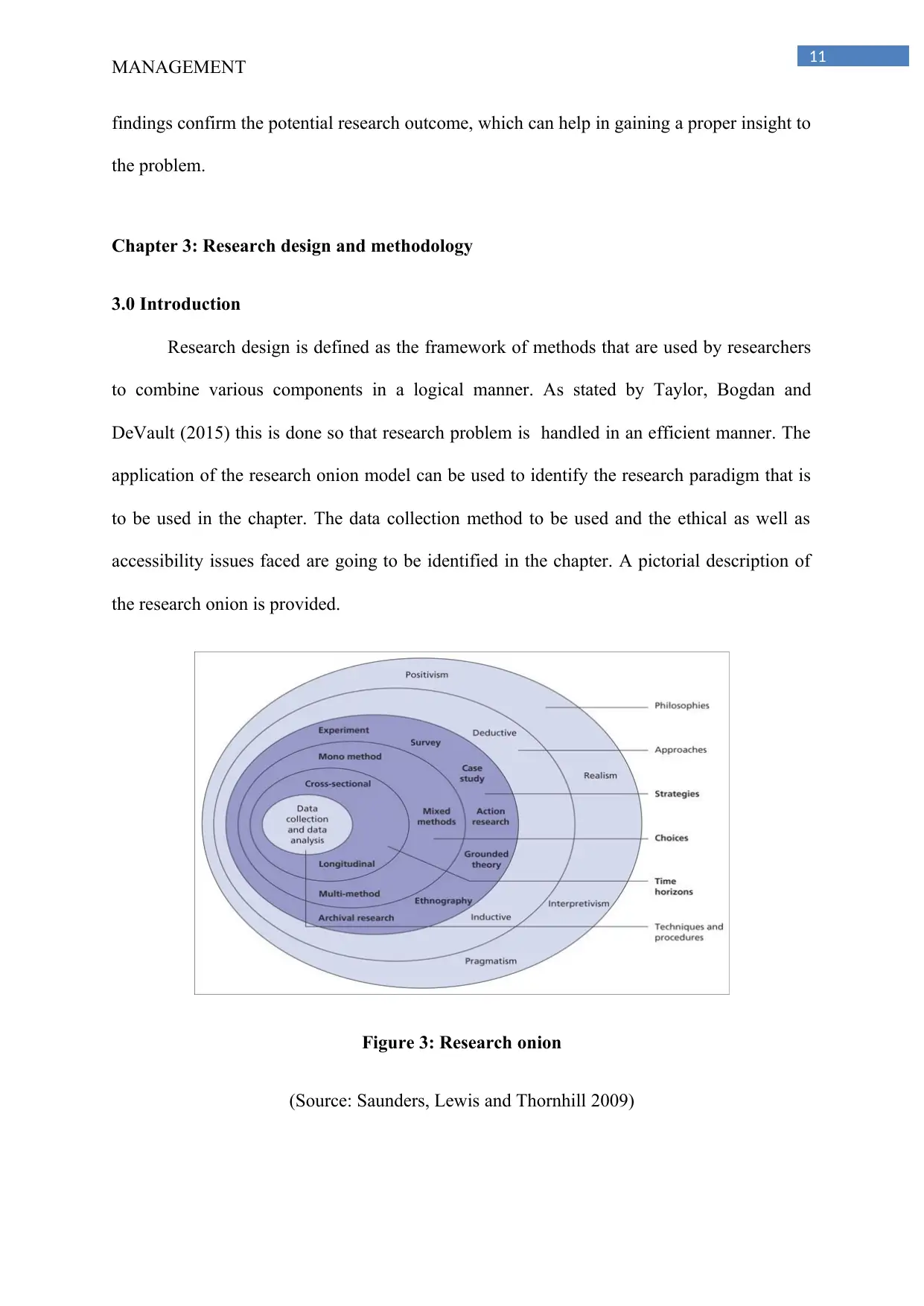
11
MANAGEMENT
findings confirm the potential research outcome, which can help in gaining a proper insight to
the problem.
Chapter 3: Research design and methodology
3.0 Introduction
Research design is defined as the framework of methods that are used by researchers
to combine various components in a logical manner. As stated by Taylor, Bogdan and
DeVault (2015) this is done so that research problem is handled in an efficient manner. The
application of the research onion model can be used to identify the research paradigm that is
to be used in the chapter. The data collection method to be used and the ethical as well as
accessibility issues faced are going to be identified in the chapter. A pictorial description of
the research onion is provided.
Figure 3: Research onion
(Source: Saunders, Lewis and Thornhill 2009)
MANAGEMENT
findings confirm the potential research outcome, which can help in gaining a proper insight to
the problem.
Chapter 3: Research design and methodology
3.0 Introduction
Research design is defined as the framework of methods that are used by researchers
to combine various components in a logical manner. As stated by Taylor, Bogdan and
DeVault (2015) this is done so that research problem is handled in an efficient manner. The
application of the research onion model can be used to identify the research paradigm that is
to be used in the chapter. The data collection method to be used and the ethical as well as
accessibility issues faced are going to be identified in the chapter. A pictorial description of
the research onion is provided.
Figure 3: Research onion
(Source: Saunders, Lewis and Thornhill 2009)
⊘ This is a preview!⊘
Do you want full access?
Subscribe today to unlock all pages.

Trusted by 1+ million students worldwide
1 out of 23
Related Documents
Your All-in-One AI-Powered Toolkit for Academic Success.
+13062052269
info@desklib.com
Available 24*7 on WhatsApp / Email
![[object Object]](/_next/static/media/star-bottom.7253800d.svg)
Unlock your academic potential
Copyright © 2020–2025 A2Z Services. All Rights Reserved. Developed and managed by ZUCOL.





